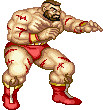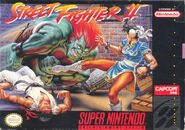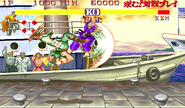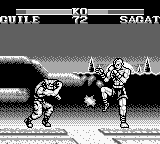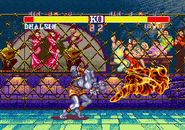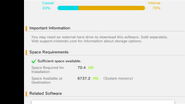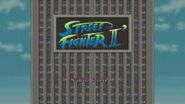Street Fighter II: The World Warrior (ストリートファイターⅡ Sutorīto Faitā Tsū?) is a 1991 fighting game produced by Capcom, originally released as an arcade game. The second main installment in the Street Fighter series and the critically acclaimed sequel to the original Street Fighter, Street Fighter II greatly improved upon many of the concepts introduced in the first game, including the use of command-based special moves and a six-button control configuration, while offering players a selection of multiple playable characters, each with their own unique fighting style and special moves.
Street Fighter II is widely credited with starting the fighting game boom during the 1990s. Its popularity led to the production of several updated versions, each offering additional features and characters over previous versions, as well as many home versions; the game itself also established many of the core concepts of the fighting game genre, with some successful series inspired by it such as Mortal Kombat and Killer Instinct. Some of the home versions of the Street Fighter II games have sold millions of copies, with the Super NES port of the first Street Fighter II being Capcom's best-selling consumer game of all-time as of 2008.
Gameplay[]

Ryu and Ken fighting on Guile's stage in three different versions of Street Fighter II. From top to bottom: the original Street Fighter II, Street Fighter II': Champion Edition/Hyper Fighting and Super Street Fighter II/Turbo/Hyper.
Street Fighter II follows several of the conventions and rules already established by its original 1987 predecessor. The player engages opponents in one-on-one close quarter combat in a series of best-two-out-of-three matches. The objective of each round is to deplete the opponent's vitality before the timer runs out. If both opponents knock each other out at the same time or the timer runs out with both fighters having an equal amount of vitality left, a "double KO" or "draw game" is declared and additional rounds will be played until sudden death. In the first Street Fighter II, a match could last up to ten rounds if there was no clear winner; this was reduced to four rounds in Street Fighter II: Champion Edition and onward. If there is no clear winner by the end of the final round, then either the computer-controlled opponent will win by default in a single-player match or both fighters will lose in a 2-player match.
After every third match in the single player mode, the player will participate in a "bonus game" for additional points. The bonus games includes (in order) a car-breaking event; a barrel breaking bonus game where the barrels are dropped off from a conveyor belt above the player; and a drum-breaking bonus game where drums are flammable and piled over each other. The bonus games were removed from the original version of Super Street Fighter II Turbo in exchange for a bonus fight against Akuma during the final stage.
Like in the original, the games controls uses a configuration of an eight-directional joystick and six attack buttons. The player uses the joystick to jump, crouch and move the character towards or away from the opponent, as well as to guard the character from an opponent's attacks. There are three punch buttons and three kick buttons of differing strength and speed (Light, Medium and Heavy). The player can perform a variety of basic moves in any position, including grabbing/throwing attacks, which were not featured in the original Street Fighter. Like in the original, the player can perform special moves by inputting a combination of directional and button-based commands, but execution of these moves is much easier than in the original game, a significant factor in its popularity.
Street Fighter II differs from the original in its roster of multiple playable characters, each with their distinct fighting styles and special moves. Additionally, the player can also "cancel" attacks during their animation by performing another move, allowing for a combination of several basic and special moves. Both of these features would be expanded upon in subsequent installments.
Characters[]

The original character select screen, often hailed as the most memorable select screen in the series.
The original version of Street Fighter II featured a roster of eight playable characters. Ryu and Ken, the main characters from the original Street Fighter, appeared along with six new characters of different nationalities:
- E. Honda, a sumo wrestler from Japan who wants to prove his fighting style.
- Blanka, a beast-like man from Brazil who, after a horrible discoloration, longs for a happier life.
- Guile, a former special forces operative from the United States of America who seeks to avenge his best friend.
- Chun-Li, a female martial artist and ICPO agent from China who seeks to avenge her father.
- Zangief, a pro wrestler and national hero from the U.S.S.R. (present-day Russia).
- Dhalsim, a wise Yogi from India who seeks to help his village home.
The single player tournament mode also features four CPU-controlled opponents whom the player faces after defeating the other main characters. The bosses in the game are:
- Balrog (M. Bison in the Japanese version), an African-American boxer who was banned from formal tournaments.
- Vega (Balrog in Japan), a vain and conceited claw-wielding, ninja-like Spanish matador, bullfighter and top assassin.
- Sagat, a one-eyed Muay Thai master from Thailand and the former champion of the original Street Fighter.
- M. Bison (Vega in Japan), a mysterious military commander and leader of a secret drug cartel and crime organization known as Shadaloo.
The boxer character was named M. Bison in Japan (with the "M" standing for "Mike"), since he was modeled on real-life world heavyweight champion boxer Mike Tyson.
When Street Fighter II was released overseas, the names of the bosses were rotated, because the character of "M. Bison" resembled Mike Tyson to the point of likeness infringement and also because Capcom USA's marketing team believed that "Vega" was a "weak-sounding name" for the game's final opponent, whose character and theme they wanted to further emphasize.
From Champion Edition and onward, the boss characters became playable, expanding the selectable roster to twelve, and the player could now face against an opponent who used the same character. This meant that the player faced all twelve characters, including a clone of themselves, during the single-player tournament.
Super Street Fighter II introduced four new characters from previously unrepresented nationalities to the pre-existing roster:
- T. Hawk, an indigenous warrior from Mexico whose ancestral homeland was taken from him by M. Bison; he seeks to reunite his people.
- Cammy, a young member of the Secret Intelligence Service known as Delta Red from England who has a mysterious past tied to M. Bison.
- Fei Long, a martial arts movie star from Hong Kong who seeks to follow his own path of real-life martial arts.
- Dee Jay, a kickboxing musician and dancer from Jamaica who is searching for inspiration for his new song.
The new characters were designed by Capcom's internal artists in Japan, except for Dee Jay, whose original design was contributed to the game by American designer James Goddard. The character roster was now increased to sixteen, although the player still faced only twelve opponents, including the original four bosses, in the single-player tournament.
Super Street Fighter II Turbo featured another new powerful character whom the player faced (after meeting certain conditions) in the game's final match instead of M. Bison. This character, who was unnamed within the actual game, was officially referred to as Gouki in Japan and as Akuma in the English version; the different names stuck in their respective territories. Akuma is a man under the influence of the Satsui no Hado and uses the Assassination Fist style that Ryu and Ken use, but he's faster, can shoot a Hadoken in mid air, can teleport, and can perform the style's notorious hidden technique, the Shun Goku Satsu, in which he teleports to the opponent, the screen darkens, and all that's visible are impact marks. When the screen turns back to normal, Akuma is seen standing of over the body of his opponent with the kanji 天 (Heaven) glowing on his back. Akuma is playable only by entering a special cheat code in the character selection screen. A Gameboy Advance titled Super Street Fighter II Turbo Revival also adds a more powerful version of Akuma called Shin Akuma, previously seen in Street Fighter Alpha series, where he is normally a hidden character.
Ultra Street Fighter II features two additional characters, both of whom first appeared in games released after Super Street Fighter II Turbo. The original version of Akuma, much like in Super Street Fighter II Turbo Revival and later Street Fighter games is now a regular character, while his Shin Akuma version is a hidden playable character in this game via selectable cheat code:
- Evil Ryu, the malicious form Ryu takes on whenever he succumbs to the Satsui no Hado, previously seen in the Street Fighter Alpha series and the Street Fighter IV series.
- Violent Ken, Ken under the control of M. Bison's Psycho Power, previously seen in the crossover game, SNK vs. Capcom: SVC Chaos.
| Name | Country | Appearance | Summary |
|---|---|---|---|
| Akuma | Japan | 
|
Akuma, also known as Gouki in Japanese versions of Street Fighter II, debuts as a secret character in Super Street Fighter II Turbo. He is fought under certain conditions and is playable via cheats. Akuma is widely considered to be "broken" - unbeatable when in the hands of a skilled player - and is very tough to defeat when the computer controls him as well. He entered the tournament unofficially. Akuma's moves are similar to Ryu's and Ken's Hadouken, Tatsumaki, and Shoryuken, but his moves are much stronger. In Super Street Fighter II Turbo HD Remix, he can be selected on the top of E. Honda. In Super Street Fighter II Turbo Revival and Ultra Street Fighter II, he becomes a regular playable character, whereas his Shin version as a hidden character. |
| Balrog | U.S.A. | 
|
Balrog, also known as Mike Bison in Japanese versions of Street Fighter II, is a boxer employed by M. Bison of Shadaloo, and one of Bison's chief lieutenants. He fights only with his fists. In Street Fighter II: The World Warrior, he was a computer-only boss character, but became playable in Street Fighter II: Champion Edition. His signature moves are his Turn Punch and Dash Straight. |
| Blanka | Brazil | 
|
Blanka is a Brazilian man whose body has become green due to his consumption of excessive chlorophyll in the jungles he lives in. He is famous for his electrical attack, Electric Thunder, and rolling attacks such as Beast Roll. |
| Cammy White | England | 
|
Cammy is a character introduced in Super Street Fighter II. She is notable for being the second playable female character in the game. Cammy has some mysterious ties with M. Bison, but little else about her is known from Street Fighter II's storyline. Her signature move is the Cannon Drill. |
| Chun-Li | China | 
|
Chun-Li is well known for being not only the first playable female character in the Street Fighter series, but in the whole fighting game genre. Chun-Li, while not as strong as the rest of the cast, is very agile and quick. She enters the tournament to get revenge on M. Bison for the death of her father. Her most recognizable attack is the Lightning Kick. |
| Dee Jay | Jamaica | 
|
Dee Jay is a Jamaican fighter introduced in Super Street Fighter II. He is a singer who has taken interest in the tournament to gain publicity. Dee Jay is almost always smiling. He is a close-up fighter with a diverse moveset. His most notable attack is the Max Out. |
| Dhalsim | India | 
|
Dhalsim is one of the most memorable fighters of the cast not only for his unique personality, but also for his long-range body-stretching moves and flaming attacks. He was formerly a pacifist, but entered the tournament to raise money for his poor village. Dhalsim is known for his Yoga Fire and Yoga Flame. |
| Edmond Honda | Japan | 
|
E. Honda is a sumo-wrestler from Japan. He enters the tournament to prove that sumo wrestling is the best fighting style in the world. E. Honda is very strong offensively and known for his Hundred Hand Slap and Sumo Headbutt. |
| Evil Ryu | Japan | 
|
Evil Ryu is what Ryu becomes if the Satsui no Hado overtakes himself. Gameplay-wise, he is Ryu but with some of Akuma's moves mixed in. Evil Ryu was introduced in Ultra Street Fighter II: The Final Challengers, and he is most well known for his ability to teleport via the Ashura Senku, and his deadly super art, the Shun Goku Satsu. |
| Fei Long | Hong Kong (China) | 
|
Fei Long is an action movie actor who first appeared in Super Street Fighter II. He is a tribute to Kung-fu legend Bruce Lee. He joins the tournament to seek a fighting experience outside of the choreographed and scripted scenes of his films. His most notable move is the Shienkyaku. |
| Guile | U.S.A. | 
|
Guile enters the tournament to arrest M. Bison for causing the death of his best friend, Charlie Nash. He is very well known for his glitches, excellent combo ability, and ability to launch Sonic Booms and Flash Kicks. |
| Ken Masters | U.S.A. | 
|
Ken is a "clone character" of Ryu - they fight with a very similar style, but have some differences in later iterations of the game. Ken enters the tournament because Ryu encourages him to join. He and Ryu are well known for their Hadoken, Tatsumaki, and Shoryuken attacks; Ken would introduce the flaming Shoryuken in Super Street Fighter II. |
| M. Bison | Fights in Thailand (Unknown nationality) |

|
M. Bison, also known as Vega in Japanese versions of Street Fighter II, is the leader of the criminal organization Shadaloo. He is the organizer of the tournament. Bison has dark ambitions and is an enemy of several of the tournament's participants. In Street Fighter II: The World Warrior, he was a computer-only boss character, but later became a playable character in Street Fighter II: Champion Edition. His signature attack is the Psycho Crusher. |
| Ryu | Japan | 
|
Ryu is a Japanese fighter who enters the tournament to test his skills. Ryu is considered a "beginner" character, a character who is easy to learn. He and Ken are very famous for their signature Hadoken, Tatsumaki, and Shoryuken attacks (though Ryu's Shoryuken isn't as strong as Ken's). Ryu and Sagat have a history, having first fought at the first World Warrior tournament. |
| Sagat | Thailand | 
|
Sagat is the previous tournament's champion. However, an intense post-fight altercation with challenger Ryu left his body scarred, as well as his pride. He enters the tournament to seek revenge on Ryu. Sagat is also a member of Shadaloo. Sagat is well known for his Tiger Shot projectile and Tiger Uppercut. He is a computer-controlled boss character in Street Fighter II: The World Warrior, but became playable in Street Fighter II: Champion Edition. |
| Shin Akuma | Japan | 
|
Shin Akuma, also known as Shin Gouki in Japanese versions of Street Fighter II, debuts as a unlockable character in Super Street Fighter II Turbo Revival. A powerful version of Akuma. The differences besides the color palettes between him and his original version is mostly having double shots of Zanku Hadoken. While exclusively appeared in Super Street Fighter II Turbo Revival, he later re-appear as secret character in Ultra Street Fighter II, whereas a regular version Akuma becomes a regular playable character. |
| Thunder Hawk | Mexico | 
|
T. Hawk is a Native American fighter who enters to seek revenge on Bison for destroying his native land. He was introduced in Super Street Fighter II. His most famous attack is the Mexican Typhoon. |
| Vega | Spain | 
|
Vega, also known as Balrog in Japanese versions of Street Fighter II, is a Spanish fighter employed by Shadaloo. He uses a mixture of bullfighting and ninjutsu. Vega is famous for his fast, long ranged claw attacks and for his mask. He is a computer-controlled boss character in Street Fighter II: The World Warrior, but became playable in Street Fighter II: Champion Edition. Vega is best known for his Back Slash. |
| Violent Ken | U.S.A. | 
|
Violent Ken is what Ken becomes if he is brainwashed by M. Bison's power. He is a more ruthless, aggressive, valiant, daring, fearless, and cutthroat version of Ken. Much like Akuma and Evil Ryu, he fights using the Ansatsuken, or murder fist. Violent Ken was introduced in Ultra Street Fighter II: The Final Challengers, and is best known for his extremely fast movement speed. |
| Zangief | U.S.S.R. (Russia) | Zangief is a Russian bear-wrestler. Zangief uses powerful close up attacks and his famous Spinning Piledriver. He enters the tournament to prove the strength of the Russian spirit. |
Non-Playable Characters[]
- Q (Appears in Ken's stage from the original and Champion Edition variants, is absent in the Super iterations of the game)
- Eliza Masters (Appears in Ken's ending)
- Gorbachev (Appears in Zangief's ending)
- Samantha (Appears in Blanka's ending)
- Julia (Appears in Guile's Ending)
- Amy (Appears in Guile's Ending)
- Datta (Appears in Dhalsim's Ending)
- Sally (Appears in Dhalsim's Ending in the Super Turbo iteration only)
Arcade release history[]
Street Fighter II[]

Guile defeats Ken after using his Flash Kick (arcade version).
Street Fighter II: The World Warrior is the first iteration of the Street Fighter II series, released in March 1991. The game featured all of the basic features that would be carried over to subsequent Street Fighter II editions. The original game featured eight selectable characters, with Ryu and Ken being the only characters with identical moves, although they are still subtly different in a few small ways. In the single-player tournament, the player faces against the other seven main characters, before proceeding to the final four opponents, which were non-selectable boss characters. In World Warrior, matches could go up to ten rounds if there were no clear winner before making the player lose by default. The early revisions of this version featured several glitches, such as Guile's infamous "invisible throw" and "Golden Stance".
Street Fighter II': Champion Edition[]
Street Fighter II': Champion Edition was released in April 1992, and is the first update to the game. The four boss characters from the first edition became selectable characters and a feature was added that allowed two players to select the same character, with one character being distinguished from the other with an alternate color scheme. Characters using any of their palette swaps have their names printed in blue below their health bar. The number of opponents in the single-player mode increased to twelve due to the addition of clone matches. Some of the artwork was redrawn as well and the stages' backgrounds were recolored. Much of the gameplay was revised to balance the characters. From this edition onward, the maximum number of rounds was reduced to four.
Champion Edition is known for being the base of a number of illegally sold hacks due to its popularity. One in particular is Street Fighter II: Rainbow Edition.
Street Fighter II' Turbo: Hyper Fighting[]
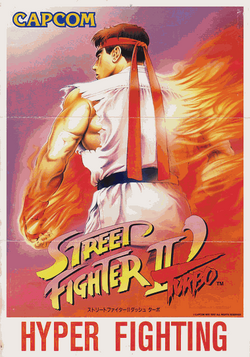
Street Fighter II Turbo: Hyper Fighting was a minor update released in response to the proliferation of modified bootlegs of Champion Edition. Released in December 1992 (eight months after Champion Edition), Hyper Fighting increased the game speed and added new special techniques for some of the characters such as Dhalsim's Yoga Teleport and Chun-Li's Kikoken. All of the characters received new color schemes; the new scheme became the default scheme, with the original scheme available as the alternate for all characters except M. Bison, who still used his original scheme as the default and the new scheme as the alternate.
Super Street Fighter II[]

Promotional leaflet for Super Street Fighter II, featuring the 16 characters in their numerous color patterns they wear in the game.
Super Street Fighter II: The New Challengers (スーパーストリートファイターⅡ Sūpā Sutorīto Faitā Tsū?), was released in October 1993. The fourth game in the Street Fighter II series, Super was the first Capcom game produced for the CPS II hardware, instead of the CPS hardware the previous games were released on. New graphics were drawn for the game, including an all new attract sequence. Characters received new animation frames for their attacks and win poses, and the four bosses received new animation frames for their basic attacks (Vega and Sagat for example, did not have actual jumping punches in previous versions). All of the audio was remade for the game as well.
In addition to the returning twelve characters from previous versions, Super also introduced four new selectable characters (T. Hawk, Cammy, Fei-Long and Dee-Jay), increasing the character roster to sixteen. The single-player mode against the CPU, however, did not change: like in previous versions, players fight against eight opponents, now randomly selected, before facing the four bosses, for a total of twelve fights. Each character now had eight selectable color schemes: in addition to their regular colors, player can also select their characters in their Champion Edition and Hyper Fighting colors, or choose one of five new color schemes.
The arcade version of Super Street Fighter II was widely criticized for its return to the original slower gameplay pace of World Warrior and Champion Edition, leading to the release of Super Street Fighter II Turbo. In spite of this, its home console ports enable the player to speed up the game.
Super Street Fighter II Turbo[]

Promotional leaflet for Super Street Fighter II Turbo, depicting the new character Akuma.
Super Street Fighter II Turbo, known in Japan as Super Street Fighter II X: Grand Master Challenge (スーパーストリートファイターⅡX Sūpā Sutorīto Faitā Tsū Ekusu?), was released in March 1994. The main new feature in Super Turbo is the ability to perform a new type of special move called "Super Combos", with one available for each character. A Super Combo is a special move, usually a more extensive and effective upgrade of each character's standard special move by delivering more hits, that can only be performed by filling out the Super Combo gauge. The Super Combo gauge is filled as the player performs regular and special moves against their opponent, which will be emptied again once a Super Combo is performed. When an opponent is defeated with a Super Combo, the background will flash yellow and red.
Other additional features are added to the gameplay in Super Turbo such as the ability to "juggle" or perform a combo against an opponent falling in the air. This can be done by connecting an air combo-capable attack with another air combo attack or with a Super Combo (and vice versa). The player can also escape from a throwing or holding attack and make a safe fall, reducing the damage from the attack. Finally, as indicated by the name, Super Turbo returns to the quicker pace of Hyper Fighting after the slower gameplay of Super Street Fighter II.
Hyper Street Fighter II[]
Hyper Street Fighter II: The Anniversary Edition (ハイバーストリートファイタ-Ⅱ Haipā Sutorīto Faitā Tsū?) is the sixth and final arcade iteration of Street Fighter II, released on December 2003, nearly ten years after Super Turbo, in Japan and Southeast Asia only. Hyper was a special version of Street Fighter II produced to commemorate the 15th anniversary of the Street Fighter series. The game system is based on Super Turbo, but with the added feature of being able to select between characters from all five preceding iterations of Street Fighter II. Players can choose between "Normal", "Champ" ("Dash" in Japan), "Turbo", "Super" and "Super T" ("Super X" in Japan) versions of the game's cast and match against any other version (e.g.: "Normal" Ken against "Turbo" Ryu). Each particular version of a character will have the same set of moves, animation frames and voice samples of the game they represent. Some characters are only available in certain modes: for example Cammy is only available in "Super" and "Super T", while Sagat is not selectable in "Normal". Furthermore, "Normal" versions of character cannot be matched against another "Normal" version of the same character (i.e.: "Normal" Guile cannot fight another "Normal" Guile). All of the computer-controlled opponents in the single-player mode will fight in "Super T" mode only.
The arcade version of Hyper Street Fighter II was not released in North America and Europe. Instead, the game was released in those territories via its PlayStation 2 and Xbox ports.
Super Street Fighter II Turbo HD Remix[]

Promotional leaflet for Super Street Fighter II HD Remix, depicting Ryu and Akuma in HD quality. Artwork by UDON.
Super Street Fighter II Turbo HD Remix is the 7th iteration of Street Fighter II and a major remake of Super Street Fighter II Turbo featuring the original game and a "remixed" version featuring high definition graphics drawn by UDON Entertainment, arranged music by OverClocked ReMix, and massively rebalanced gameplay. The game has been designed by Backbone Entertainment's David Sirlin to be the sixth, definitive version of Street Fighter II.
Like Hyper Street Fighter II, the player can play classic versions of each character (Akuma included). The classic versions do not have a super bar and can't reduce throw damage, but are considered stronger overall.
Ultra Street Fighter II: The Final Challengers[]

Ultra Street Fighter II: The Final Challengers character group artwork by Bengus.
Ultra Street Fighter II: The Final Challengers is the newest, and presumably the final, iteration of Street Fighter II. Released for the Nintendo Switch in May 2017, the game adds Evil Ryu and Violent Ken to the roster of playable fighters. There are two options for the graphics; classic and Turbo HD Remix graphics.
Ports[]
Consoles[]

The very first home version produced by Capcom was the Super NES version of Street Fighter II: The World Warrior, released on June 10, 1992 in Japan and in July in North America. This version introduced the 2-Player Versus Mode that allowed players to adjust their handicap and features a cheat code that allows two players to select the same character like in Champion Edition. Capcom released the "Capcom Power Stick Fighter", a joystick controller made specifically for the game that was backward-compatible with the original NES.
In 1993, a PC-Engine version of Street Fighter II Dash was produced by NEC Avenue and released in Japan on June 12. A six-button controller was released specifically for the game. When the game is played on a standard PC-Engine controller, then the Run button is used, along with the I and II buttons, as attack buttons, with the Select button used to toggle between punches and kicks.
A second Super NES version by Capcom, simply titled Street Fighter II Turbo (spelled without the prime mark, even in its Japanese release), was released shortly afterwards on July 10 in Japan and on August in North America. The primary game mode in this version is "Turbo" mode, which is based on the arcade version of Hyper Fighting. The SNES version of Turbo allows players to adjust the game's speed from zero (normal) to four stars, with six additional speed settings available via a cheat code. A secondary game mode called "Normal" is also available, which is based on the arcade version of Champion Edition.

Gameplay of the Sega Genesis Special Champion Edition. This version is generally regarded as more "arcade perfect" than the Super NES release and even having access to glitches such as CPS1 Chains.
A Genesis/Mega Drive port was produced titled Street Fighter II: Special Champion Edition (known as Street Fighter II Dash Plus in Japan and promoted as Street Fighter II′ Plus), released in Japan on September 28 and during the same month in North America. Special Champion Edition features much of the same content as Turbo for the SNES, except the primary game mode is "Champ" ("Dash" in the Japanese version), a game mode based on the arcade Champion Edition, while the secondary game mode available is "Hyper" ("Exciting" in the Japanese version), based on Hyper Fighting. This port contains an exclusive five-on-five "Group Battle" mode and the ability to disable any of the characters' special moves in Versus Mode. Sega produced a six-button controller specifically for the game, which later became the standard Genesis controller. Capcom also produced a Genesis version of their CPS Fighter controller. Unlike the previous SNES and PC-Engine ports, this version features the original attract sequence from the original arcade game featuring the two generic street fighters fighting in front of a crowd. In the western versions of the port, the dark-skinned fighter who gets defeated by the light-skinned fighter is recolored to another white fighter, likely to avoid racism.
In 1994, Capcom produced ports of Super Street Fighter II for the Super NES and Genesis/Mega Drive were released on June 25 in Japan and in August in North America. Both ports feature the standard arcade style mode (dubbed "Super Battle"), as well as a 2-Player "Vs. Battle" and the "Group Battle" mode from the previous Mega Drive/Genesis edition. Both ports also feature an eight-player "Tournament Battle" mode, similar to the "Tournament Battle" version of the arcade Super Street Fighter II, as well as a "Time Battle" mode, in which a single player must defeat the computer in a single-round match in the best time possible.
A version of Super Street Fighter II Turbo for the 3DO was on November 1994. This port features an arranged version of the original CPS II soundtrack.
In 1997, Capcom released a compilation for the PlayStation and Sega Saturn titled Street Fighter Collection, a two-disc set which features Super Street Fighter II and Super Turbo on one disc and Street Fighter Alpha 2 Gold (or Street Fighter Alpha 2 Dash), a minor upgrade of the original Street Fighter Alpha 2, on the other.
A Master System port of Street Fighter II′ was also released in 1997 for the Brazilian market, published by Tec Toy. This version, based on Champion Edition, hence the prime symbol, features only eight characters: Dhalsim, Honda, Zangief and Vega are not in this version.
In 1998, a second compilation titled Street Fighter Collection 2 was released for the PlayStation, which features the original Street Fighter II, Champion Edition and Hyper Fighting, as well as a new "Super Vs. Mode" that allows player to select between character variants from all three games. This compilation was also released for the Saturn in Japan as Capcom Generation Vol. 5.
In 2000, Capcom released Super Street Fighter II X for Matching Service for the Dreamcast in Japan as a mail-order title via Dreamcast Direct. This version which features an online-compatible Vs. Mode and restores the bonus rounds from previous Street Fighter II games which were removed from the arcade version of Super Turbo.
In 2003, Capcom released Hyper Street Fighter II for the PlayStation 2 in Japan and Europe. Similar to the "Super Vs. Mode" in Street Fighter Collection 2, this version of the game allows players to select from different versions of the selectable from the five arcade games. Hyper includes an option for CPS, CPS II and Arranged soundtrack, as well as an edited cut of the Street Fighter II animated movie. The PS2 version of Hyper was released in North America as part of bundle titled Street Fighter Anniversary Collection, which also includes a PS2 port of Street Fighter III: 3rd Strike. The Anniversary Collection was later released for the Xbox in all three territories.
In 2005, Capcom released Capcom Classics Collection Vol. 1 for the PS2 and Xbox, which features all 16 games from the Capcom Generation compilations for the PlayStation, including the three Street Fighter II games. A second compilation, Capcom Classics Collection Vol. 2, released in 2006 for the PS2 and Xbox, contains the original Street Fighter and a port of Super Street Fighter II Turbo.
An online-enable version of Street Fighter II: Hyper Fighting was released for the Xbox 360 in 2006 as a downloadable game available for the Xbox Live Arcade service. A high definition remake titled Super Street Fighter II Turbo HD Remix was released in November 2008 for the Xbox Live Arcade and PlayStation Store download services. HD Remix features new sprites and backgrounds rendered with high-resolution artwork drawn by UDON Comics and remixed music by OverClocked ReMix, among other changes.
All three Street Fighter II games released for the Super NES, as well as Special Champion Edition for the Genesis, have also been released for the Wii through the Virtual Console service. The Super Nintendo versions were also released on the Wii U's Virtual Console service, with players receiving a discount for buying them if they already bought them for the Wii Virtual Console.
Portables[]
A Game Boy version of Street Fighter II was released in 1995. This version features a graphic design based on Super Street Fighter II, but features only nine of the original twelve characters. Dhalsim, E. Honda and Vega, as well as all the new characters introduced in Super and Super Turbo were left out in this version due to limited cartridge space. The controls and some of the moves were modified due to the two-button configuration of the Game Boy console. Light Punches and Kicks are performed by slightly tapping either button, while Heavy-level attacks are performed by pushing the buttons for a slightly longer period.
Super Street Fighter II Turbo Revival was later released for the GBA in 2001. Revival is not a direct port of the arcade Super Turbo, but rather an original portable version of the game based on it. The controls, much like the Game Boy version of the original Street Fighter II, have been modified due to the platform's four-button setup. Additionally "Easy Commands" can be toggled on or off to allow easier performance of special moves. Revival features all the characters from the arcade version. Two versions of Akuma (with his own Super Combo move) are unlockable but the "Old" versions of the other characters were removed. The player only has to fight 10 opponents as opposed to 12. However the car and barrel bonus stages were also included. The artwork for the character select screen, victory screen and the character endings have all been remade by Capcom artist Edayan. The English localization was also revised. The backgrounds for Ryu's, Ken's, Chun-Li's, Guile's, Zangief's, Balrog's and Bison's stages have all been replaced, with some of the backgrounds taken from the later Street Fighter Alpha and Street Fighter III games. This version of the game also includes a Training mode and two unlockable game modes: the previously seen Time Attack and Survival mode. The latter allows the player to freely play the game's bonus rounds or take on 5, 10, 30, 50 or 100 opponents, using only a single (limitedly regenerative) health bar. The game art (including the endings) of all the characters can be viewed in a designated art gallery.
The 2006 compilation Capcom Classics Collection: Reloaded for the PlayStation Portable, like its PS2 and Xbox counterpart, features all 16 games from the Capcom Generation compilations, including the three Street Fighter II games (the original, Champion Edition, and Hyper Fighting) from Street Fighter Collection 2.
Mobile phone versions of the original Street Fighter II and Champion Edition have also been released.
Computers[]
MS-DOS[]
in 1992, an MS-DOS port of Street Fighter II was developed by Creative Materials, published by U.S. Gold in Europe and by Hi Tech Expressions in the USA. This port was poorly received, featuring only two attack buttons (one punch and one kick), special moves which were more difficult to perform, and unresponsive controls when using the keyboard.
In 1995, an MS-DOS CD-ROM port of Super Street Fighter II Turbo was developed by Eurocom, and published by GameTek in North America and Europe. This port is widely praised, being very faithful to the arcade and featuring an unique remixed soundtrack (not the same as the 3DO port).
In 1996, even though Turbo had already been ported to the same system, a port of Super Street Fighter II was released for MS-DOS in CD-ROM, ported by Rozner Labs and published by Capcom. This version is based on the SNES version.
Other Western home computers[]
In 1992, U.S. Gold published ports of Street Fighter II for the Amiga, Commodore 64, Atari ST, and ZX Spectrum computers (all converted by Creative Materials, except the Spectrum version by Tiertex). All were only released in Europe.
In 1995, U.S. Gold published a port of Super Street Fighter II for the Amiga, converted by Freestyle Software. This version was only released in Europe.
In 1995, GameTek published a port of Super Street Fighter II Turbo for the Amiga, converted by Human Soft; the next year it came out on the "consolized Amiga", the Amiga CD-32. Both were only released in Europe.
Other Japanese home computers[]
A port of Street Fighter II Dash for the X68000 computer was released on November 26, 1993. This version came with an extension that allowed players to connect the Capcom Power Stick (a joystick released for the Super Famicom and Mega Drive) or any Super Famicom/Mega Drive-compatible controller into the X68000 hardware.
A port of Super Street Fighter II was ported to the X68000 (September 30, 1994, as well as the FM Towns (October 28, 1994). The FM Towns version was the first version to use the arranged soundtrack that was later used for the 3DO version of Super Street Fighter II Turbo, as well as Street Fighter Collection 2/Capcom Generation Vol. 5 for the PlayStation and Saturn, and the home versions of Hyper Street Fighter II.
Emulated releases[]
In 2003 Capcom Arcade Hits Volume 1 was released for Windows, featuring emulated arcade versions of the original Street Fighter and Street Fighter II: Champion Edition.
Street Fighter II was ported to Steam twice.
Online Gaming Platforms[]
A partnership between Capcom and NetEnt saw a Street Fighter 2: The World Warrior Slot released on the 21st May 2020.[1] Featuring all 8 of the original characters and all four bosses as playable bonus levels, the slot machine uses original graphics and soundtracks to ensure its' authenticity and, much like the game itself, simulate battles between the player and a computer-controlled secondary player to determine win ratios and payouts.
Collections[]
In 2018, Street Fighter II was released as part of the Street Fighter 30th Anniversary Collection. In 2021, it was released as DLC for Capcom Arcade Stadium.
Legacy[]
Sequels[]
The Street Fighter II games were followed by several sub-series of Street Fighter games and spinoffs which includes Street Fighter Alpha, Street Fighter EX, Street Fighter III, Super Puzzle Fighter II Turbo and Capcom's Vs. series (which combined Capcom's characters with properties from other companies such as Marvel, SNK, and Tatsunoko). Capcom released Street Fighter IV for the arcades in 2008.
Related media[]
Street Fighter II was adapted into two different film adaptations in 1994, Street Fighter II: The Animated Movie, a Japanese anime film produced by Group TAC, and an American produced live-action film, simply titled Street Fighter. The live-action film effectively incorporated the main cast of the video game and wrapped them into an action adventure.
There was also a US Street Fighter cartoon, which followed a combined Van Damme movie and game series plot, and an unrelated anime titled Street Fighter II V.
Reception[]
Guinness World Records awarded Street Fighter II three world records in the Guinness World Records: Gamer's Edition 2008. These records are "First Fighting Game to Use Combos", "Most Cloned Fighting Game", and "Biggest-Selling Coin-Operated Fighting Game." The numerous home versions of the Street Fighter II are listed among Capcom's Platinum-class titles (games which have sold more than 1 million units worldwide). As of June 30, 2008, the Super NES version of the original Street Fighter II is still the company's best-selling game, having sold more than 6.3 million units, followed by the Super NES versions of Street Fighter II Turbo (4.1 million) and Super Street Fighter II (2 million), and the Genesis version of Street Fighter II: Special Champion Edition (1.65 million). Video Game Canon ranks Street Fighter II as one of the best games of all time.[2]
Gallery[]
Promotional Art and Packaging[]
Official Art[]
- To view all official character artwork, see: Official Art.
Screenshots[]
Screenshots of Wii U Virtual Console (SNES version)[]
Trivia[]
- Although one of Street Fighter II's records in Guinness World Records: Gamer's Edition 2008 is "First Fighting Game to Use Combos", the first known fighting game that used a combo system was actually Culture Brain's Shanghai Kid (1985), the first installment of their Hiryū no Ken series.
- E. Honda's, M. Bison's, and Zangief's idle animations move in sync with each other. This is noticeable before a round starts.
- Unlike in the original Street Fighter, if the CPU Bosses "World Warrior" are hacked into the game, they could not be controlled by the player, as they were not intended to be played.
- In The World Warrior, Vega had a weakness where he could be swept again if he has hit by a sweep Knockdown. The sweeps of the playable cast were generally too slow or too short reaching to take advantage (Zangief was capable of exploiting this to a degree) of this weakness, other Vega and M. Bison were capable of doing this infinitely if their sliding sweep hits.
- The Super NES version of World Warrior M. Bison has three attacks that can't be seen in normal gameplay as the CPU Bison is not programmed to use them. The first is his hard punch aerial attack that can hit twice if Bison times the first hit. The second hit like the jumping attacks of the rest of the bosses stays active throughout his Jump. The second one uses his sliding Sweep animation but he simply stays in place then without transition frames he simply stands up, this attack gives him massive amounts of Frame advantage on hit and block. The final move he uses the initial hit of his Scissor Kick and then goes back to his standing animation.
- An unspecified console version of Street Fighter II is played in the music video for Juicy, by The Notorious B.I.G..
- The World Warrior version of Street Fighter II is featured in Sega's mobile shoot-em'-up RPG game 404 Game RE-SET -Error Game Reset- as unlockable casts during the "King's World Tour" collaboration event. The Anode cast's design is based on and inspired by Ryu, while the Cathode cast's look is based on and inspired by M. Bison. Ryu and Chun-Li themselves both appear as collectible figurines that can be unlocked during the event, and three remixed arrangements of music from the game are used for the crossover collab event; "Contender" (which is a remix of both the Title screen and Player Select BGM), "Infighting" (which is a remix of Ryu's Suzaku Castle stage BGM), and "Championship" (which is a remix of M. Bison's Temple Hideout stage BGM).

